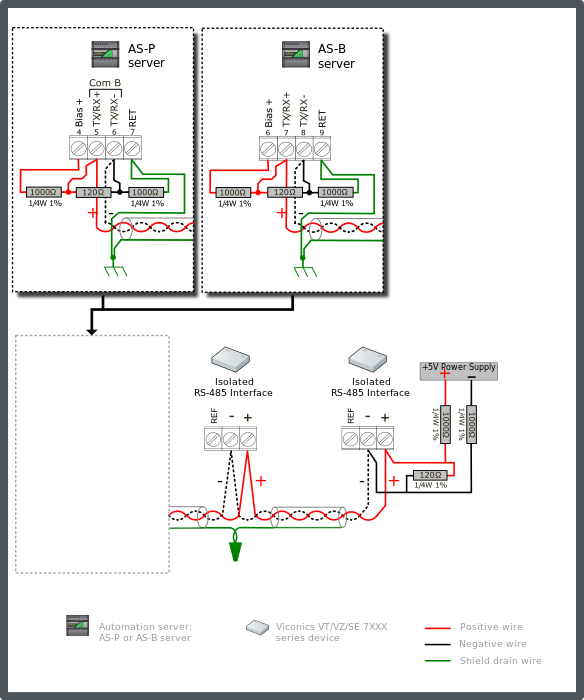
Conceito
VT/VZ7xxx Configuration 2: Dual End-point Bias (External Supply Source)
Dual end-point bias applies a separate 5 V DC supply at each end of the network to generate the RS-485 bias. Instead of a single pair of 510 ohm resistors, the dual end scheme uses a pair of 1000 ohm resistors at each end. The dual end-point is the best technique for avoiding the drop in the bias voltage over extended cable lengths as you move away from the bias connection location. By applying bias at the two termination points, the arrangement maintains an equal bias across the complete length of the cable.
When using a AS-P server or AS-B server, and the server is positioned near one end of the network cable, you can use the 5 V available on the Bias+ terminal to provide the network bias at the head end of the cable. You use a separate 5 V DC power supply to provide the network bias at the far end of the cable. The recommended power supplies are discussed separately. Para mais informações, consulte Power Supply Selection for VT/VZ7xxx Configuration 2 .
Connect a 1000 ohm bias resistor from the TX/RX+ terminal (see the figure below) to the Bias+ terminal on the AS-P server or AS-B server. Connect another 1000 ohm bias resistor from the TX/RX- terminal to the RET terminal on the AS-P server or AS-B server. Connect an external 5 V DC power supply to the MS/TP bus pair through two 1000 ohm bias resistors at the far end of the cable.
Connect a 120 ohm termination resistor across the + and - data lines at the head end of the bus (typically at the automation server). Connect another 120 ohm termination resistor across the + and - data lines on the last node at the far end of the bus.
Connect the shield drain wire to earth ground terminal rail in the control panel with the automation server. This is the only ground connection of the shield for the complete cable segment. Connect the RET terminal on the automation server to the ground rail in the panel using a 12 AWG (3.31 mm²) to 18 AWG (0.82 mm²) wire.
The shield drain wires are connected together at each device, allowing the shield to continue on past the devices for the full length of the bus.
Use only twisted pair bus cable specified for use with RS-485 (for example, Belden 9841 or equivalent). Para mais informações, consulte Cable Selection .
The example diagram below shows the alternate RS-485 terminal block connections for the different automation server models.
The example diagram below shows the RS-485 Com B connections on the AS-P and AS-B servers. The guidelines are the same for Com A.

The recommended maximum cable length is 1200 m (4000 ft), if using a 24 AWG (0.20 mm²) or larger cable.
The maximum sensor/node count is 38 (using only the VT/VT7xxx devices). The node count reduces if mixed network with non-isolated devices (such as b3 BACnet devices). Node count discussions and other limiting factors are described separately. Para mais informações, consulte Expanded Unit Load with Network of Isolated Devices Only (Viconics VT/VZ7xxx Devices) .
The recommended location for the bias is at the two extreme ends of the network cable, but the bias voltage remains effective with a 60 m (200 ft) tolerance on the cable length from the end. This configuration supports the preferred termination resistor values of 120 ohm with one positioned at each end of the cable. The unit load imposed by the dual end-point bias is 24UL (12,000 / (1,000 / 2)).
 Viconics VT/VZ/SE 7xxx Series Devices
Viconics VT/VZ/SE 7xxx Series Devices
 VT/VZ7xxx Configurations
VT/VZ7xxx Configurations
 Cable Selection
Cable Selection
 Expanded Unit Load with Network of Isolated Devices Only (Viconics VT/VZ7xxx Devices)
Expanded Unit Load with Network of Isolated Devices Only (Viconics VT/VZ7xxx Devices)
 Power Supply Selection for VT/VZ7xxx Configuration 2
Power Supply Selection for VT/VZ7xxx Configuration 2